| Duke Ellington: "Money Jungle" (United Artists, Feb. 1963) |
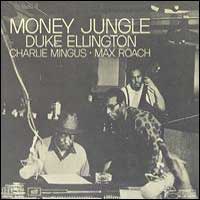 Ellington + Mingus + Roach = Ein Gigantentreffen. Eine der wenigen Aufnahmen
von Ellington in kleiner Triobesetzung. Aufgenommen am 17. Sept. 1962
Ellington + Mingus + Roach = Ein Gigantentreffen. Eine der wenigen Aufnahmen
von Ellington in kleiner Triobesetzung. Aufgenommen am 17. Sept. 1962
(28.02.2009)

 Mehr ...
Mehr ...
Duke Ellington surprised the jazz world in 1962 with his historic trio session featuring Charles Mingus and Max Roach. Not in a mood to simply rework older compositions, the bulk of the LP focused on music he wrote specifically for the session. "Money Jungle" is a thunderous opener, a blues that might be classified somewhere between post-bop and avant-garde. The gem of the date is the fragile, somewhat haunting ballad "Fleurette Africaine," where Mingus' floating bassline and Roach's understated drumming add to the mystique of an Ellington work that has slowly been gathering steam among jazz musicians as a piece worth exploring more often. "Very Special" is a jaunty upbeat blues, while the angular, descending line of "Wig Wise" also proves to be quite catchy. Ellington also revisits "Warm Valley" (a lovely ballad indelibly associated with Johnny Hodges) and an almost meditative "Solitude." Thunderous percussion and wild basslines complement a wilder-than-usual approach to "Caravan." Every jazz fan should own a copy of this sensational recording session.
(by Ken Dryden, All Music Guide)
|
| The Beach Boys: "Surfer Girl" (Capitol, April 1963) |
 "Surfer Girl" war das dritte Album der Jungs und trug erstmals offiziell
den Hinweis "Produced By Brian Wilson", der hier fû¥r groûartige
Arrangements sorgte und die HarmoniegesûÊnge perfektionierte. Der
Titelsong und besonders "In My Room" sind dabei meine absoluten
Favoriten auf dem Album. Allerdings habe ich recht lange dafû¥r gebraucht,
mich û¥berhaupt fû¥r die Beach Boys zu interessieren: Der Zugang
kam û¥ber "Pet Sounds"
Mitte der 90er und Brian Wilsons Comeback in den letzten Jahren. Inzwischen
kann ich aber auch das Frû¥hwerk geniessen und stelle fest: da ist
mir doch bislang einiges durch die Lappen gegangen!
"Surfer Girl" war das dritte Album der Jungs und trug erstmals offiziell
den Hinweis "Produced By Brian Wilson", der hier fû¥r groûartige
Arrangements sorgte und die HarmoniegesûÊnge perfektionierte. Der
Titelsong und besonders "In My Room" sind dabei meine absoluten
Favoriten auf dem Album. Allerdings habe ich recht lange dafû¥r gebraucht,
mich û¥berhaupt fû¥r die Beach Boys zu interessieren: Der Zugang
kam û¥ber "Pet Sounds"
Mitte der 90er und Brian Wilsons Comeback in den letzten Jahren. Inzwischen
kann ich aber auch das Frû¥hwerk geniessen und stelle fest: da ist
mir doch bislang einiges durch die Lappen gegangen!
Ein Tipp: legt euch die CD-WiederverûÑffentlichung von 2001 zu: ein
beeindruckender Sound, vor allem natû¥rlich bei den HarmoniegesûÊngen.
Auûerdem gibt es ein Bonusalbum ("Shot Down, Part II" mit einem
meiner allerliebsten Brian Wilson Songs: "The Warmth Of The Sun")
und noch mehr Bonustracks (z.B. "In My Room" auf deutsch: "Ganz
Allein" - auch nicht schlimmer als "Sie Liebt Dich" von
den Beatles).
(Juli 2003)
|
| Bob Dylan: "The Freewheelin´ Bob Dylan" (Columbia, Mai 1963) |
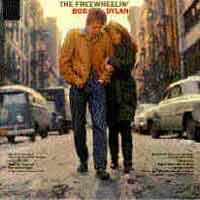 Mit diesem Album Nr.2 gelang Dylan damals der Durchbruch. Die Liste der Songklassiker
auf dem Album ist beeindruckend: "Blowin' In The Wind", "Master
Of War", "A Hard Rain's Gonna Fall", "Don't Think
Twice, It's Alright" und "Girl From The North Country".
Mit diesem Album Nr.2 gelang Dylan damals der Durchbruch. Die Liste der Songklassiker
auf dem Album ist beeindruckend: "Blowin' In The Wind", "Master
Of War", "A Hard Rain's Gonna Fall", "Don't Think
Twice, It's Alright" und "Girl From The North Country".
|
| "Judy Henske" (Elektra, Mai 1963) |
 Auf dem Cover ihres Elektra-Debû¥ts macht Judy Henske zwar nicht
diesen Eindruck - aber es geht hier um eine gelungene Verbindung von Folk
und Jazz, live und mit einer Big Band. Die Dame hat eine beeindruckende
Stimme und macht Ansagen zu den Liedern, die manchmal noch besser sind
als die Lieder selber. EnthûÊlt auûerdem die ûÊlteste, mir bekannte Version
des spûÊteren Grateful Dead-Klassikers "I Know You Rider".
Auf dem Cover ihres Elektra-Debû¥ts macht Judy Henske zwar nicht
diesen Eindruck - aber es geht hier um eine gelungene Verbindung von Folk
und Jazz, live und mit einer Big Band. Die Dame hat eine beeindruckende
Stimme und macht Ansagen zu den Liedern, die manchmal noch besser sind
als die Lieder selber. EnthûÊlt auûerdem die ûÊlteste, mir bekannte Version
des spûÊteren Grateful Dead-Klassikers "I Know You Rider".

 Mehr ...
Mehr ...
On this live LP, Henske, as she would throughout most of her career, eludes easy categorization. There's barrelhouse blues with a touch of Broadway belting, there's Dixielandish jazz, there are folk standards, and there's plenty of standup comedy between the songs. The husky, almost raunchy voice makes most of this worth hearing; one is tempted to describe her as one of the great White blues singers, except that there's a theatrical quality to much of her delivery that originates from pop traditions. She's at her best when she eschews the jivey jazz for a more straight folk-blues approach (on "Wade in the Water," "I Know You Rider," and "Love Henry").
(by Richie Unterberger, All Music Guide)
|
| Charles Mingus: "The Black Saint And The Sinner Lady" (Impulse, Juli 1963) |
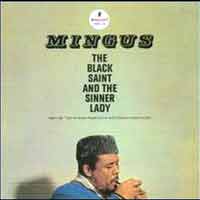 Ich bin war kein wirklicher Mingus-Kenner oder gar Jazz-Spezialist, doch
man kommt nicht daran vorbei festzustellen, dass Mingus einer der wichtigsten
Bassisten und Komponisten des Jazz ist. Bekanntester Mitspieler aus Sicht
eines "Jazz-Aussenseiters": Charlie Mariano, den es Ende
der 60er nach Europa zog, wo er z.B. mit der deutschen Gruppe Embryo
und dem United Jazz & Rock Ensemble zusammenarbeitete.
Ich bin war kein wirklicher Mingus-Kenner oder gar Jazz-Spezialist, doch
man kommt nicht daran vorbei festzustellen, dass Mingus einer der wichtigsten
Bassisten und Komponisten des Jazz ist. Bekanntester Mitspieler aus Sicht
eines "Jazz-Aussenseiters": Charlie Mariano, den es Ende
der 60er nach Europa zog, wo er z.B. mit der deutschen Gruppe Embryo
und dem United Jazz & Rock Ensemble zusammenarbeitete.

 Mehr ...
Mehr ...
| "This 1963 recording occupies a special place in Mingus's
work, his most brilliantly realized extended composition. The six-part suite
is a broad canvas for the bassist's tumultuous passions, ranging from islands
of serenity for solo guitar and piano to waves of contrapuntal conflict
and accelerating rhythms that pull the listener into the musical psychodrama.
It seems to mingle and transform both the heights and clichés of
jazz orchestration, from Mingus's master, Duke Ellington, to film noir soundtracks.
The result is a masterpiece of sounds and textures, from the astonishing
vocal effects of the plunger-muted trumpets and trombone (seeming to speak
messages just beyond the range of understanding) to the soaring romantic
alto of Charlie Mariano. Boiling beneath it all are the teeming, congested
rhythms of Mingus and drummer Dannie Richmond and the deep morass of tuba
and baritone saxophone. This is one of the greatest works in jazz composition,
and it's remarkable that Mingus dredged this much emotional power from a
group of just 11 musicians." (Stuart Broomer ) |
|
| Stan Getz/Joao Gilberto: "Getz/Gilberto" (Verve, Okt. 1963) |
 Diese
Platte war ein echtes Ereignis: zum ersten mal kam es vor einer breiten
ûÑffentlichkeit zur Verbindung von Jazz und Bossa Nova. Der US-amerikanische
Saxofonist Stan Getz und der brasilianische SûÊnger und Gitarrist
Joao Gilberto schufen eine wunderbare Kombination dieser beiden
Welten. Unverzichtbar dabei der brasilianische Komponist und Pianist Antonio
Carlos Jobim, dessen Lieder den BûÊrenanteil des Albums ausmachen:
"Girl From Ipanema", "Corcovado", "Desafinado"
und weitere. "Ipanema" wurde sogar zum Welthit und prûÊsentiert
als Besonderheit Joao Gilbertos Ehefrau Astrud Gilberto, damals
eigentlich keine professionelle SûÊngerin, die nur gebeten wurde,
Jobims portugiesische Texte als Demo in englisch zu singen, da ihr Mann
die englische Sprache nicht beherrschte. Das Ergebnis war so û¥berzeugend,
dass ihr Gesang fû¥r "Ipanema" und ein anderes Lied in der
Endversion belassen wurden. Leider hat man fû¥r die gekû¥rzte
Singleversion sogar Joao´s portugiesisch gesungene Strophen herausgeschnitten,
wodurch "Ipanema" alleine zu Astruds Hit wurde! Diese
Platte war ein echtes Ereignis: zum ersten mal kam es vor einer breiten
ûÑffentlichkeit zur Verbindung von Jazz und Bossa Nova. Der US-amerikanische
Saxofonist Stan Getz und der brasilianische SûÊnger und Gitarrist
Joao Gilberto schufen eine wunderbare Kombination dieser beiden
Welten. Unverzichtbar dabei der brasilianische Komponist und Pianist Antonio
Carlos Jobim, dessen Lieder den BûÊrenanteil des Albums ausmachen:
"Girl From Ipanema", "Corcovado", "Desafinado"
und weitere. "Ipanema" wurde sogar zum Welthit und prûÊsentiert
als Besonderheit Joao Gilbertos Ehefrau Astrud Gilberto, damals
eigentlich keine professionelle SûÊngerin, die nur gebeten wurde,
Jobims portugiesische Texte als Demo in englisch zu singen, da ihr Mann
die englische Sprache nicht beherrschte. Das Ergebnis war so û¥berzeugend,
dass ihr Gesang fû¥r "Ipanema" und ein anderes Lied in der
Endversion belassen wurden. Leider hat man fû¥r die gekû¥rzte
Singleversion sogar Joao´s portugiesisch gesungene Strophen herausgeschnitten,
wodurch "Ipanema" alleine zu Astruds Hit wurde! |
| Luiz Bonfa: "Plays And Sings Bossa Nova" (Verve, 1963) |
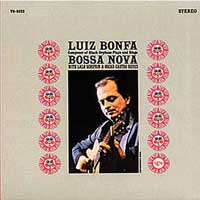 Vielleicht
nicht so bekannt wie Antonio Carlos Jobim ist Luiz Bonfa aber trotzdem
einer der wichtigsten Vertreter dieser damals absolut trendmûÊûigen Musik
aus Brasilien. Sowohl als SûÊnger, aber vor allem als Gitarrist, glûÊnzt
er hier. Am bekanntesten sind wohl seine Kompositionen fû¥r den Spielfilm
"Black Orpheus" von 1959: den "Samba De Orfeu" (hier
leider nicht vertreten) kennt garantiert jeder von Euch! Vielleicht
nicht so bekannt wie Antonio Carlos Jobim ist Luiz Bonfa aber trotzdem
einer der wichtigsten Vertreter dieser damals absolut trendmûÊûigen Musik
aus Brasilien. Sowohl als SûÊnger, aber vor allem als Gitarrist, glûÊnzt
er hier. Am bekanntesten sind wohl seine Kompositionen fû¥r den Spielfilm
"Black Orpheus" von 1959: den "Samba De Orfeu" (hier
leider nicht vertreten) kennt garantiert jeder von Euch! |
| Kenny Burrell: "Midnight Blue" (Blue Note, 1963) |
|
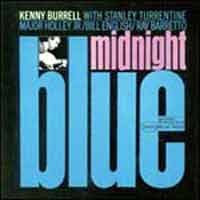 Ein
grooviges Album des Gitarristen und in den 90ern eine der meistgesamplten
Vorlagen fû¥r den so genannten "Acid-Jazz". Aber keine
Sorge: es handelt sich um ein wirklich gutes Album, nur vielleicht fû¥r
Jazzpuristen etwas zu "kommerziell" - aber was soll´s? Ein
grooviges Album des Gitarristen und in den 90ern eine der meistgesamplten
Vorlagen fû¥r den so genannten "Acid-Jazz". Aber keine
Sorge: es handelt sich um ein wirklich gutes Album, nur vielleicht fû¥r
Jazzpuristen etwas zu "kommerziell" - aber was soll´s?
An den Congas ist der legendûÊre Ray Barretto dabei, das
Saxofon blûÊst Stanley Turrentine - auch eine Legende!
|
| John Coltrane Quartet: "Ballads" (Impulse, 1963) |
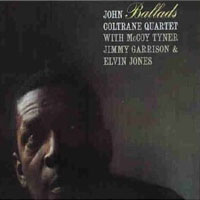 Der
Titel des Albums sagt es klar und deutlich: Balladen. Auch wenn damals
John Coltrane schon als einer der Groûen galt, so war er doch eher
fû¥r laute TûÑne bekannt, wenn auch (noch) nicht fû¥r Free-Jazz.
Auf jeden Fall macht er hier deutlich, dass er auch einer der besten Interpreten
von Balladen war. Ich wage zu behaupten, dass das Album sogar fû¥r
Nicht-Jazz-Fans hûÑrbar ist. Aufgenommen im November 1962 vom klassischen
Coltrane-Quartett mit McCoy Tyner, Elvin Jones und Jimmy
Garrison. Der
Titel des Albums sagt es klar und deutlich: Balladen. Auch wenn damals
John Coltrane schon als einer der Groûen galt, so war er doch eher
fû¥r laute TûÑne bekannt, wenn auch (noch) nicht fû¥r Free-Jazz.
Auf jeden Fall macht er hier deutlich, dass er auch einer der besten Interpreten
von Balladen war. Ich wage zu behaupten, dass das Album sogar fû¥r
Nicht-Jazz-Fans hûÑrbar ist. Aufgenommen im November 1962 vom klassischen
Coltrane-Quartett mit McCoy Tyner, Elvin Jones und Jimmy
Garrison.

 Mehr ...
Mehr ...
ÿ£¢
Those who find Coltraneãs music challenging should give this cool gem a spin. It finds the saxophonist in a reposeful mood, offering fairly laidback late-night renditions of eight jazz standards, including Gene DePaulãs ãYou Donãt Know What Love Isã. Ballads features the same musicians (Tyner, Garrison and Jones) that served up A Love Supreme, but the music is more reflective and less intense. Even so, itãs still a classic Coltrane opus dominated by a distinctive probing saxophone sound. If A Love Supreme is a step too far for those looking to buy John Coltrane for the first time, then Ballads is much more palatable.
(www.udiscovermusic.com)
|
| John Coltrane: "Impressions" (Impulse!, 1963) |
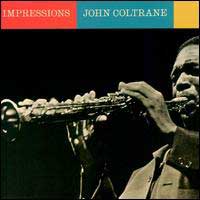 Vier
Lieder aus drei verschiedenen Aufnahmesessions (3. Nov. 1961 - 29 April
1963), die auch noch mehr als ein Jahr auseinander liegen; Live- und Studioaufnahmen;
Unterschiedliche Besetzungen: trotzdem eine regulûÊre VerûÑffentlichung
von John Coltrane zu Lebzeiten - und auch ein sehr gutes Album. Vor allem
wegen "India" mit Coltrane am Sopransaxofon (nach meiner Meinung
sein zweiter groûer Auftritt an dem Instrument nach "My Favorite
Things"!) und Eric Dolphy an der Bassklarinette. Ausserdem
neben McCoy Tyners "Live At Newport"-Album, leider das einzige
Impulse -Album, das ich auf Vinyl besitze, wenn auch nur als billige italienische
Pressung - aber immerhin schon seit den spûÊteren 70ern in meinem Plattenregal! Vier
Lieder aus drei verschiedenen Aufnahmesessions (3. Nov. 1961 - 29 April
1963), die auch noch mehr als ein Jahr auseinander liegen; Live- und Studioaufnahmen;
Unterschiedliche Besetzungen: trotzdem eine regulûÊre VerûÑffentlichung
von John Coltrane zu Lebzeiten - und auch ein sehr gutes Album. Vor allem
wegen "India" mit Coltrane am Sopransaxofon (nach meiner Meinung
sein zweiter groûer Auftritt an dem Instrument nach "My Favorite
Things"!) und Eric Dolphy an der Bassklarinette. Ausserdem
neben McCoy Tyners "Live At Newport"-Album, leider das einzige
Impulse -Album, das ich auf Vinyl besitze, wenn auch nur als billige italienische
Pressung - aber immerhin schon seit den spûÊteren 70ern in meinem Plattenregal!
(08.03.2009) |
| John Coltrane: "Stardust" (Prestige, 1963) |
 Aufnahmen von zwei Sessions aus dem Jahr 1958, die aber nach meiner EinschûÊtzung
erst 1963 verûÑffentlicht wurden, als Coltrane zum Star der Jazzszene
geworden war. Kein sehr bekanntes Album des Meisters, aber ein sehr schûÑnes:
ich liebe den Balladenspieler Coltrane, hier mit dem Klassiker "Stardust"
von Hoagy Carmichael und drei weiteren Standards. Mit dabei Pianist Red
Garland und Bassist Paul Chambers, mit denen er zuvor im Miles
Davis Quintet gespielt hatte, sowie Jimmy Cobb bzw. Art
Taylor am Schlagzeug und der damals noch sehr junge Freddie
Hubbard bzw. der mir nicht bekannte Wilbur Harden an der Trompete.
Aufnahmen von zwei Sessions aus dem Jahr 1958, die aber nach meiner EinschûÊtzung
erst 1963 verûÑffentlicht wurden, als Coltrane zum Star der Jazzszene
geworden war. Kein sehr bekanntes Album des Meisters, aber ein sehr schûÑnes:
ich liebe den Balladenspieler Coltrane, hier mit dem Klassiker "Stardust"
von Hoagy Carmichael und drei weiteren Standards. Mit dabei Pianist Red
Garland und Bassist Paul Chambers, mit denen er zuvor im Miles
Davis Quintet gespielt hatte, sowie Jimmy Cobb bzw. Art
Taylor am Schlagzeug und der damals noch sehr junge Freddie
Hubbard bzw. der mir nicht bekannte Wilbur Harden an der Trompete.
(01.01.2008)

 Mehr ...
Mehr ...
|
In 1958, John Coltrane had yet to take the modal post-bop plunge. He was still a hard bopper, although his "sheets of sound" solos were certainly among the most interesting, creative, and distinctive that bop had to offer in the late '50s. Stardust contains some highlights of two bop-oriented Coltrane dates from 1958: one is a July 11 session with trumpeter/flugelhornist Wilbur Harden, pianist Red Garland, bassist Paul Chambers, and drummer Jimmy Cobb, the other is a December 26 session with Garland, Chambers, trumpeter Freddie Hubbard, and drummer Art Taylor. When Fantasy reissued Stardust on CD for its Original Jazz Classics (OJC) series in 1997, the July 11 session had long been available in its entirety (except for alternate takes) on a disc titled The Stardust Session; however, performances of "Then I'll Be Tired of You" and "Time After Time" (both from the December 26 session) had only been available on CD as part of the 16-CD box set The Complete Prestige Recordings. At both sessions, Coltrane's playing is quite engaging. He is a lyrical, expressive ballad player on "Then I'll Be Tired of You," "Stardust," and "Time After Time," but he swings fast and aggressively on "Love Thy Neighbor" (the only track on this 39-minute CD that isn't a ballad). And at both sessions, Coltrane is well served by Garland's piano and Chambers' bass. When Coltrane was playing alongside those jazzmen in Miles Davis' 1955-1957 quintet, he enjoyed a strong rapport with both of them and that rapport wasn't any less strong in 1958. It is no coincidence that Prestige's A&R department united Coltrane with Garland and Chambers so often; Prestige knew how compatible all of them were. Although not quite essential, Stardust paints a consistently attractive picture of Coltrane's 1958 output.
(by Alex Henderson, All Music Guide)
|
|
| Buddy Emmons: "Steel Guitar Jazz" (Verve/Mercury, 1963) |
|
 Sommer 2003. Ich bin mit meinem schûÑnen neuen Roller mal wieder
unterwegs und lande mal wieder vor einem Plattenladen (passiert mir
oft, aber nicht jedes mal!). Ist ja auch praktisch mit einem Zweirad,
denn man kann auch in einer groûen Stadt wie Essen direkt vor
dem Laden parken!
Sommer 2003. Ich bin mit meinem schûÑnen neuen Roller mal wieder
unterwegs und lande mal wieder vor einem Plattenladen (passiert mir
oft, aber nicht jedes mal!). Ist ja auch praktisch mit einem Zweirad,
denn man kann auch in einer groûen Stadt wie Essen direkt vor
dem Laden parken!
Nun ja - zurû¥ck zum Thema: bei "Zweitausendeins" (mein
Gott - wie die Zeit vergeht: der Name war in den 70ern und 80ern mal
futuristisch und ich habe vor einigen Jahren noch darû¥ber gegrû¥belt,
was mit dem Laden bei der Jahrtausendwende passieren wû¥rde. Jetzt
ist es schon 2003 und nix ist - Gott sei Dank- passiert!).
ALSO JETZT WIRKLICH ZURû¥CK ZUM THEMA! Bei "Zweitausendeins"
blûÊttere ich eigentlich immer gerne durch die gute und preiswerte
Auswahl an Jazzplatten (das hat auch unser "Steeler" Rainer
Mû¥ller entdeckt: siehe "Kind
Of Blue" von Miles Davis!) und finde dabei dieses vûÑllig
schrûÊge Ding: Jazzstandards auf der Pedalsteel! Das klingt dann
wohl fû¥r die meisten Leute genauso schrûÊg und ungenieûbar
wie zu erwarten. Da ich aber nun schon seit einiger Zeit vom Virus "Steelguitar"
befallen bin und ich auch keine Angst vor Jazz habe (ganz im Gegenteil!)
und Buddy Emmons wirklich ein Meister an dem Instrument ist, war klar,
dass ich die Platte haben musste. Zumal das CD-Reissue in einem tollen
Pappcover, an eine alte Vinylscheibe erinnernd, daherkommt. Tolle Platte!

 Mehr ...
Mehr ...
"Steel Guitar Jazz is one of those obscure records
that jazz enthusiasts love. A true oddity, the 1963 release features a conventional
rhythm section behind the unique steel guitar of Buddy Emmons. The steel
guitar is normally associated with country and Hawaiian music, yet Emmons
makes a convincing argument for the instrument as a force in jazz. Gary
Burton would later make good use of Emmons in his country-tinged records,
but this recording constitutes a foray into mainstream jazz.
The presentation takes a little getting used to (and may cause a snicker
at first) but there's no doubt that the quintet has serious aspirations
in mind. The novelty of the concept certainly carries you through the first
few songs, but there's no doubt that Emmons is a heck of a musician and
knows his jazz licks. The rest of the band provides sturdy accompaniment,
but only Jerome Richardson gets any significant solo space and makes the
most of it. Steel Guitar Jazz is an oddball record that transcends the gimmickry,
easily making it a worthwhile experience." |
|
| Chico Hamilton: "Passin' Thru" (Impulse!, 1963) |
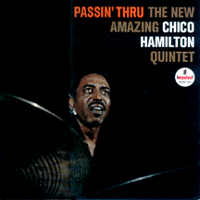 Neben
Art Blakey ist Chico Hamilton sicherlich der bekannteste trommelnde Bandleader
im Modern Jazz. Dieses "erstaunliche neue Quintett" hatte eine
phantastische Besetzung mit jungen Musikern, denen zum Teil noch Groûes
bevorstand: Saxofonist und FlûÑtist Charles Lloyd, Gitarrist
Gabor Szabo, Posaunist George Bohannon und der leider frû¥h
verstorbene Bassist Albert Stinson. Highlight unter lauter hochklassigen
Liedern ist das 13minû¥tige "Lady Gabor", komponiert vom
ungarischen Gitarrenspieler. Neben
Art Blakey ist Chico Hamilton sicherlich der bekannteste trommelnde Bandleader
im Modern Jazz. Dieses "erstaunliche neue Quintett" hatte eine
phantastische Besetzung mit jungen Musikern, denen zum Teil noch Groûes
bevorstand: Saxofonist und FlûÑtist Charles Lloyd, Gitarrist
Gabor Szabo, Posaunist George Bohannon und der leider frû¥h
verstorbene Bassist Albert Stinson. Highlight unter lauter hochklassigen
Liedern ist das 13minû¥tige "Lady Gabor", komponiert vom
ungarischen Gitarrenspieler.
(18.02.2011)

 Mehr ...
Mehr ...
Drummer Chico Hamilton's debut on Impulse featured his fifth Quintet, an advanced hard bop unit that sometimes hinted a little at the avant-garde. Instead of the trademark cello, the band featured trombonist George Bohanon. With Charles Lloyd (doubling on tenor and flute), guitarist Gabor Szabo and bassist Albert Stinson all contributing fresh new voices, this was a major band.
(by Scott Yanow, All Music Guide)
|
| Joe Henderson: "Page One" (Bue Note, 1963) |
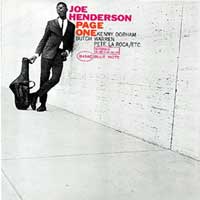 Das
Blue Note-Debû¥t des Tenorsaxofonisten enthûÊlt mit "Blue Bossa"
vom an der Aufnahmesession beteiligten Trompeter Kenny Dorham die
Originalversion eines Jazzklassikers. Fû¥r mich bleibt aber unerklûÊrlich,
warum der hier ausgezeichnet aufspielende Pianist McCoy Tyner als
einziger auf dem Froncover namentlich nicht genannt wird und unter "etc."
firmiert. Das
Blue Note-Debû¥t des Tenorsaxofonisten enthûÊlt mit "Blue Bossa"
vom an der Aufnahmesession beteiligten Trompeter Kenny Dorham die
Originalversion eines Jazzklassikers. Fû¥r mich bleibt aber unerklûÊrlich,
warum der hier ausgezeichnet aufspielende Pianist McCoy Tyner als
einziger auf dem Froncover namentlich nicht genannt wird und unter "etc."
firmiert.

 Mehr ...
Mehr ...
Tenor saxophonist Joe Henderson's debut as a leader is a particularly strong and historic effort. With major contributions made by trumpeter Kenny Dorham, pianist McCoy Tyner, bassist Butch Warren, and drummer Pete La Roca, Henderson (who already had a strikingly original sound and a viable inside/outside style) performs six generally memorable compositions on this CD reissue. Highlights include the original versions of Dorham's "Blue Bossa" and Henderson's "Recorda Me." It's highly recommended.
(by Scott Yanow, All Music Guide)
Renowned for his gruff but soulful tenor saxophone tone, Ohio-born Henderson was 26 when he recorded his debut LP, Page One, which opens with the classic track, ãBlue Bossa,ã written by trumpeter Kenny Dorham, who also plays on the album. From the sensuous rhythms of the Brazilian bossa nova style, the album moves on to encompass driving hard bop (ãHomestretchã), reflective ballads (ãLa Meshaã), cool modal jazz (ãRecorda Meã) and slow, after-hours blues (ãOut Of The Nightã). A stunning debut.
(www.udiscovermusic.com)
|
| Freddie Hubbard: "The Body & The Soul" (Impulse!, 1963) |
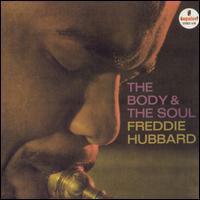 Freddie's zweite Platte bei Coltranes Hauslabel.
Dieses mal nicht mit kleiner Combo, sondern im Septett, unterstû¥tzt
von Big Band und Streichern, arrangiert von Kumpel Wayne Shorter,
der sich hier als Musiker weitestgehend zurû¥ckhûÊlt. Tolle Musik
in phantastischem Sound (natû¥rlich von Rudy van Gelder aufgenommen!).
Freddie's zweite Platte bei Coltranes Hauslabel.
Dieses mal nicht mit kleiner Combo, sondern im Septett, unterstû¥tzt
von Big Band und Streichern, arrangiert von Kumpel Wayne Shorter,
der sich hier als Musiker weitestgehend zurû¥ckhûÊlt. Tolle Musik
in phantastischem Sound (natû¥rlich von Rudy van Gelder aufgenommen!).
(Juni 2006)

 Mehr ...
Mehr ...
The second of trumpeter Freddie Hubbard's two Impulse albums features the 25-year old in three separate settings. He is heard along with tenor-saxophonist backed by with strings ("Skylark," "I Got It Bad" and "Chocolate Shake" are all given beautiful treatments), with a 16-piece band and in a septet with Eric Dolphy and Wayne Shorter. This well-rounded and highly recommended showcase shows why Freddie Hubbard was considered the top trumpeter to emerge during the early '60s.
(by Mark Deming, All Music Guide)
At age 25, Freddie Hubbard made inroads into modern jazz most trumpeters could not imagine, much less come through with. As a soloist, one of Hubbard's crowning achievements in his early period was this recording on which he teamed with Wayne Shorter, marginally as a performer but prominent in the role of arranger/conductor for his first time ever. Utilizing a septet, 16-piece big band, and orchestra plus stings to play concise, tight tunes, Shorter provides the backdrop to employ Hubbard's bold toned trumpet and all of its devices in a full display of his powerful melodic talents. Yeoman Reggie Workman plays bass on all selections, with drummer Louis Hayes in the seven-piece combo, and great work from Philly Joe Jones in the larger bands. Interestingly enough, the three tracks with the smaller ensemble are the most interesting, due to the presence of Eric Dolphy, Curtis Fuller, Cedar Walton, and Shorter on the front line. "Clarence's Place" is a post-bop jewel with spiky brass accents and Dolphy's ribald and outre alto sax solo contrasting Shorter's relatively reserved tenor, "Dedicated to You" is a wisp of a tune, while "Body & Soul," an atypical choice for the opening selection, is a straight read of the classic ballad with a chart that sounds larger than the small horn section, and a wavering flute via Dolphy. The big band does an unusual soul-jazz treatment of the Brazilian number "Manha de Carnaval" flavored by Robert Northern's French horn, while "Aries" is a hard bop show stopper with two-note accents buoying Hubbard's great lyrical lines, and goes further into hard bop with "Thermo" as the horns demand attention with the trumpeter as an afterthought. The string section, ten pieces strong, joins the big band on the film noir type Duke Ellington piece "Chocolate Shake," the stock "I Got It Bad," and "Skylark," with its soft clarion intro bubbling underneath with the violins, violas, and cellos. The manner in which this recording is programmed is thoughtful in that it lends to the diversity of the project, but is seamless from track to track. Dan Morgenstern's hefty liner notes also explain the concept behind this ambitious project, one which did not compare to any of Hubbard's other recordings in his career. Therefore it stands alone as one of the most unique productions in his substantive discography, and a quite credible initial go-round for Shorter as an orchestrator.
collapse
(by Michael G. Nastos, All Music Guide)
|
| Vinicius de Moraes & Odette Lara:"Vinicius & Odette Lara" (Elenco, 1963) |
 Ein Meisterwerk des Bossa Nova. Das Songschreiberteam Vinicius de Moraes
und Baden Powell liefert hier bei ihrer ersten Zusammenarbeit solche
Klassiker wie "Berimbau" und "Deixa".
Ein Meisterwerk des Bossa Nova. Das Songschreiberteam Vinicius de Moraes
und Baden Powell liefert hier bei ihrer ersten Zusammenarbeit solche
Klassiker wie "Berimbau" und "Deixa".
(13.01.2009)

 Mehr ...
Mehr ...
The poet/performer Vinicius de Moraes and the vocalist Odette Lara make a wonderful team, and
though their voices aren't heard together as much as they should be here, Vinicius & Odette
Lara is a warm, inviting collection. The dozen songs are all originals by de Moraes and old
friend Baden Powell, who also appears as a musician and usually present Lara and de Moraes
trading lines, or Lara taking the verses while de Moraes handles choruses. The breathtaking
"Samba Preludio" is one of the few actual duets; after a preface featuring a mournful de Moraes
over a sawing cello, Lara sings a few lines alone as well before the pair's voices intertwine
(even while they sing different lines). Moacyr Santos' arrangements range from Brazilian bossa
to string orchestra pop to anthemic soul-jazz, with plenty of trumpet and flute as well as a
warm cocktail piano and the usual sewing machine bossa percussion. On "Deve se Amor," playful
reeds and high-note trumpet accent a smooth, powerful vocal by Lara. It's a bit disconcerting
to hear a Brazilian vocal album without recognizing at least one standard, but Vinicius & Odette
Lara is a challenging, entertaining work of jazzy Brazilian pop.
(by John Bush, All Music Guide)
It was a different century, a different world. In 1963, a poet and an actress could open a label
(hat a responsibility!), singing song from a rand-new partnership, with arrangements from a
complete stranger, and create a classic. The poet was Vinicius de Moraes, and the actress was
Odette Lara, veterans of thousand musical nights. The new partnership was Baden Powell and
Vinicius de Moraes, with born standards like Deixa, Astronauta and Berimbau.
The arranger was none other than Moacir Santos. The Label was Elenco. Today we know that it
couldn't have gone wrong.
(Ruy Castro, liner notes)
|
| Horace Parlan: "Happy Frame Of Mind" (Blue Note, 1963) |
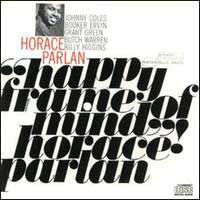 Klassischer Blue-Note-Sound von einem eher unbekannten Pianisten. Wunderbar
entspannende Musik, die sicherlich nicht so aufregend ist wie das, was
zur selben Zeit von John Coltrane, Thelonius
Monk und anderen gemacht wurde - aber eben doch auch sehr schûÑn
und auf keinen Fall "beliebig" oder so was wie schnûÑde
"Barmusik". Neben dem etwas blusigen, etwas eckigen Klavierspiel
von Horace Parlan fallen besonders die fliessenden Soli der BlûÊser
auf (Booker Erwin am Tenorsax und Johnny Coles an der Trompete),
daneben gibt es aber auch schûÑne Gitarresoli vom Meister Grant
Green zu geniessen!
Klassischer Blue-Note-Sound von einem eher unbekannten Pianisten. Wunderbar
entspannende Musik, die sicherlich nicht so aufregend ist wie das, was
zur selben Zeit von John Coltrane, Thelonius
Monk und anderen gemacht wurde - aber eben doch auch sehr schûÑn
und auf keinen Fall "beliebig" oder so was wie schnûÑde
"Barmusik". Neben dem etwas blusigen, etwas eckigen Klavierspiel
von Horace Parlan fallen besonders die fliessenden Soli der BlûÊser
auf (Booker Erwin am Tenorsax und Johnny Coles an der Trompete),
daneben gibt es aber auch schûÑne Gitarresoli vom Meister Grant
Green zu geniessen!
(10.12.2006

 Mehr ...
Mehr ...
The file texte/HoraceParlan-Happy.htm does not exist
|
 Ellington + Mingus + Roach = Ein Gigantentreffen. Eine der wenigen Aufnahmen
von Ellington in kleiner Triobesetzung. Aufgenommen am 17. Sept. 1962
Ellington + Mingus + Roach = Ein Gigantentreffen. Eine der wenigen Aufnahmen
von Ellington in kleiner Triobesetzung. Aufgenommen am 17. Sept. 1962 Mehr ...
Mehr ...
 "Surfer Girl" war das dritte Album der Jungs und trug erstmals offiziell
den Hinweis "Produced By Brian Wilson", der hier fû¥r groûartige
Arrangements sorgte und die HarmoniegesûÊnge perfektionierte. Der
Titelsong und besonders "In My Room" sind dabei meine absoluten
Favoriten auf dem Album. Allerdings habe ich recht lange dafû¥r gebraucht,
mich û¥berhaupt fû¥r die Beach Boys zu interessieren: Der Zugang
kam û¥ber "Pet Sounds"
Mitte der 90er und Brian Wilsons Comeback in den letzten Jahren. Inzwischen
kann ich aber auch das Frû¥hwerk geniessen und stelle fest: da ist
mir doch bislang einiges durch die Lappen gegangen!
"Surfer Girl" war das dritte Album der Jungs und trug erstmals offiziell
den Hinweis "Produced By Brian Wilson", der hier fû¥r groûartige
Arrangements sorgte und die HarmoniegesûÊnge perfektionierte. Der
Titelsong und besonders "In My Room" sind dabei meine absoluten
Favoriten auf dem Album. Allerdings habe ich recht lange dafû¥r gebraucht,
mich û¥berhaupt fû¥r die Beach Boys zu interessieren: Der Zugang
kam û¥ber "Pet Sounds"
Mitte der 90er und Brian Wilsons Comeback in den letzten Jahren. Inzwischen
kann ich aber auch das Frû¥hwerk geniessen und stelle fest: da ist
mir doch bislang einiges durch die Lappen gegangen! Mit diesem Album Nr.2 gelang Dylan damals der Durchbruch. Die Liste der Songklassiker
auf dem Album ist beeindruckend: "Blowin' In The Wind", "Master
Of War", "A Hard Rain's Gonna Fall", "Don't Think
Twice, It's Alright" und "Girl From The North Country".
Mit diesem Album Nr.2 gelang Dylan damals der Durchbruch. Die Liste der Songklassiker
auf dem Album ist beeindruckend: "Blowin' In The Wind", "Master
Of War", "A Hard Rain's Gonna Fall", "Don't Think
Twice, It's Alright" und "Girl From The North Country".
 Auf dem Cover ihres Elektra-Debû¥ts macht Judy Henske zwar nicht
diesen Eindruck - aber es geht hier um eine gelungene Verbindung von Folk
und Jazz, live und mit einer Big Band. Die Dame hat eine beeindruckende
Stimme und macht Ansagen zu den Liedern, die manchmal noch besser sind
als die Lieder selber. EnthûÊlt auûerdem die ûÊlteste, mir bekannte Version
des spûÊteren Grateful Dead-Klassikers "I Know You Rider".
Auf dem Cover ihres Elektra-Debû¥ts macht Judy Henske zwar nicht
diesen Eindruck - aber es geht hier um eine gelungene Verbindung von Folk
und Jazz, live und mit einer Big Band. Die Dame hat eine beeindruckende
Stimme und macht Ansagen zu den Liedern, die manchmal noch besser sind
als die Lieder selber. EnthûÊlt auûerdem die ûÊlteste, mir bekannte Version
des spûÊteren Grateful Dead-Klassikers "I Know You Rider".
 Mehr ...
Mehr ...
 Ich bin war kein wirklicher Mingus-Kenner oder gar Jazz-Spezialist, doch
man kommt nicht daran vorbei festzustellen, dass Mingus einer der wichtigsten
Bassisten und Komponisten des Jazz ist. Bekanntester Mitspieler aus Sicht
eines "Jazz-Aussenseiters": Charlie Mariano, den es Ende
der 60er nach Europa zog, wo er z.B. mit der deutschen Gruppe Embryo
und dem United Jazz & Rock Ensemble zusammenarbeitete.
Ich bin war kein wirklicher Mingus-Kenner oder gar Jazz-Spezialist, doch
man kommt nicht daran vorbei festzustellen, dass Mingus einer der wichtigsten
Bassisten und Komponisten des Jazz ist. Bekanntester Mitspieler aus Sicht
eines "Jazz-Aussenseiters": Charlie Mariano, den es Ende
der 60er nach Europa zog, wo er z.B. mit der deutschen Gruppe Embryo
und dem United Jazz & Rock Ensemble zusammenarbeitete.
 Mehr ...
Mehr ...
 Diese
Platte war ein echtes Ereignis: zum ersten mal kam es vor einer breiten
ûÑffentlichkeit zur Verbindung von Jazz und Bossa Nova. Der US-amerikanische
Saxofonist Stan Getz und der brasilianische SûÊnger und Gitarrist
Joao Gilberto schufen eine wunderbare Kombination dieser beiden
Welten. Unverzichtbar dabei der brasilianische Komponist und Pianist Antonio
Carlos Jobim, dessen Lieder den BûÊrenanteil des Albums ausmachen:
"Girl From Ipanema", "Corcovado", "Desafinado"
und weitere. "Ipanema" wurde sogar zum Welthit und prûÊsentiert
als Besonderheit Joao Gilbertos Ehefrau Astrud Gilberto, damals
eigentlich keine professionelle SûÊngerin, die nur gebeten wurde,
Jobims portugiesische Texte als Demo in englisch zu singen, da ihr Mann
die englische Sprache nicht beherrschte. Das Ergebnis war so û¥berzeugend,
dass ihr Gesang fû¥r "Ipanema" und ein anderes Lied in der
Endversion belassen wurden. Leider hat man fû¥r die gekû¥rzte
Singleversion sogar Joao´s portugiesisch gesungene Strophen herausgeschnitten,
wodurch "Ipanema" alleine zu Astruds Hit wurde!
Diese
Platte war ein echtes Ereignis: zum ersten mal kam es vor einer breiten
ûÑffentlichkeit zur Verbindung von Jazz und Bossa Nova. Der US-amerikanische
Saxofonist Stan Getz und der brasilianische SûÊnger und Gitarrist
Joao Gilberto schufen eine wunderbare Kombination dieser beiden
Welten. Unverzichtbar dabei der brasilianische Komponist und Pianist Antonio
Carlos Jobim, dessen Lieder den BûÊrenanteil des Albums ausmachen:
"Girl From Ipanema", "Corcovado", "Desafinado"
und weitere. "Ipanema" wurde sogar zum Welthit und prûÊsentiert
als Besonderheit Joao Gilbertos Ehefrau Astrud Gilberto, damals
eigentlich keine professionelle SûÊngerin, die nur gebeten wurde,
Jobims portugiesische Texte als Demo in englisch zu singen, da ihr Mann
die englische Sprache nicht beherrschte. Das Ergebnis war so û¥berzeugend,
dass ihr Gesang fû¥r "Ipanema" und ein anderes Lied in der
Endversion belassen wurden. Leider hat man fû¥r die gekû¥rzte
Singleversion sogar Joao´s portugiesisch gesungene Strophen herausgeschnitten,
wodurch "Ipanema" alleine zu Astruds Hit wurde!  Vielleicht
nicht so bekannt wie Antonio Carlos Jobim ist Luiz Bonfa aber trotzdem
einer der wichtigsten Vertreter dieser damals absolut trendmûÊûigen Musik
aus Brasilien. Sowohl als SûÊnger, aber vor allem als Gitarrist, glûÊnzt
er hier. Am bekanntesten sind wohl seine Kompositionen fû¥r den Spielfilm
"Black Orpheus" von 1959: den "Samba De Orfeu" (hier
leider nicht vertreten) kennt garantiert jeder von Euch!
Vielleicht
nicht so bekannt wie Antonio Carlos Jobim ist Luiz Bonfa aber trotzdem
einer der wichtigsten Vertreter dieser damals absolut trendmûÊûigen Musik
aus Brasilien. Sowohl als SûÊnger, aber vor allem als Gitarrist, glûÊnzt
er hier. Am bekanntesten sind wohl seine Kompositionen fû¥r den Spielfilm
"Black Orpheus" von 1959: den "Samba De Orfeu" (hier
leider nicht vertreten) kennt garantiert jeder von Euch! Der
Titel des Albums sagt es klar und deutlich: Balladen. Auch wenn damals
John Coltrane schon als einer der Groûen galt, so war er doch eher
fû¥r laute TûÑne bekannt, wenn auch (noch) nicht fû¥r Free-Jazz.
Auf jeden Fall macht er hier deutlich, dass er auch einer der besten Interpreten
von Balladen war. Ich wage zu behaupten, dass das Album sogar fû¥r
Nicht-Jazz-Fans hûÑrbar ist. Aufgenommen im November 1962 vom klassischen
Coltrane-Quartett mit McCoy Tyner, Elvin Jones und Jimmy
Garrison.
Der
Titel des Albums sagt es klar und deutlich: Balladen. Auch wenn damals
John Coltrane schon als einer der Groûen galt, so war er doch eher
fû¥r laute TûÑne bekannt, wenn auch (noch) nicht fû¥r Free-Jazz.
Auf jeden Fall macht er hier deutlich, dass er auch einer der besten Interpreten
von Balladen war. Ich wage zu behaupten, dass das Album sogar fû¥r
Nicht-Jazz-Fans hûÑrbar ist. Aufgenommen im November 1962 vom klassischen
Coltrane-Quartett mit McCoy Tyner, Elvin Jones und Jimmy
Garrison.
 Mehr ...
Mehr ...
 Vier
Lieder aus drei verschiedenen Aufnahmesessions (3. Nov. 1961 - 29 April
1963), die auch noch mehr als ein Jahr auseinander liegen; Live- und Studioaufnahmen;
Unterschiedliche Besetzungen: trotzdem eine regulûÊre VerûÑffentlichung
von John Coltrane zu Lebzeiten - und auch ein sehr gutes Album. Vor allem
wegen "India" mit Coltrane am Sopransaxofon (nach meiner Meinung
sein zweiter groûer Auftritt an dem Instrument nach "My Favorite
Things"!) und Eric Dolphy an der Bassklarinette. Ausserdem
neben McCoy Tyners "Live At Newport"-Album, leider das einzige
Impulse -Album, das ich auf Vinyl besitze, wenn auch nur als billige italienische
Pressung - aber immerhin schon seit den spûÊteren 70ern in meinem Plattenregal!
Vier
Lieder aus drei verschiedenen Aufnahmesessions (3. Nov. 1961 - 29 April
1963), die auch noch mehr als ein Jahr auseinander liegen; Live- und Studioaufnahmen;
Unterschiedliche Besetzungen: trotzdem eine regulûÊre VerûÑffentlichung
von John Coltrane zu Lebzeiten - und auch ein sehr gutes Album. Vor allem
wegen "India" mit Coltrane am Sopransaxofon (nach meiner Meinung
sein zweiter groûer Auftritt an dem Instrument nach "My Favorite
Things"!) und Eric Dolphy an der Bassklarinette. Ausserdem
neben McCoy Tyners "Live At Newport"-Album, leider das einzige
Impulse -Album, das ich auf Vinyl besitze, wenn auch nur als billige italienische
Pressung - aber immerhin schon seit den spûÊteren 70ern in meinem Plattenregal! Aufnahmen von zwei Sessions aus dem Jahr 1958, die aber nach meiner EinschûÊtzung
erst 1963 verûÑffentlicht wurden, als Coltrane zum Star der Jazzszene
geworden war. Kein sehr bekanntes Album des Meisters, aber ein sehr schûÑnes:
ich liebe den Balladenspieler Coltrane, hier mit dem Klassiker "Stardust"
von Hoagy Carmichael und drei weiteren Standards. Mit dabei Pianist Red
Garland und Bassist Paul Chambers, mit denen er zuvor im Miles
Davis Quintet gespielt hatte, sowie Jimmy Cobb bzw. Art
Taylor am Schlagzeug und der damals noch sehr junge Freddie
Hubbard bzw. der mir nicht bekannte Wilbur Harden an der Trompete.
Aufnahmen von zwei Sessions aus dem Jahr 1958, die aber nach meiner EinschûÊtzung
erst 1963 verûÑffentlicht wurden, als Coltrane zum Star der Jazzszene
geworden war. Kein sehr bekanntes Album des Meisters, aber ein sehr schûÑnes:
ich liebe den Balladenspieler Coltrane, hier mit dem Klassiker "Stardust"
von Hoagy Carmichael und drei weiteren Standards. Mit dabei Pianist Red
Garland und Bassist Paul Chambers, mit denen er zuvor im Miles
Davis Quintet gespielt hatte, sowie Jimmy Cobb bzw. Art
Taylor am Schlagzeug und der damals noch sehr junge Freddie
Hubbard bzw. der mir nicht bekannte Wilbur Harden an der Trompete. Mehr ...
Mehr ...
 Mehr ...
Mehr ...
 Neben
Art Blakey ist Chico Hamilton sicherlich der bekannteste trommelnde Bandleader
im Modern Jazz. Dieses "erstaunliche neue Quintett" hatte eine
phantastische Besetzung mit jungen Musikern, denen zum Teil noch Groûes
bevorstand: Saxofonist und FlûÑtist Charles Lloyd, Gitarrist
Gabor Szabo, Posaunist George Bohannon und der leider frû¥h
verstorbene Bassist Albert Stinson. Highlight unter lauter hochklassigen
Liedern ist das 13minû¥tige "Lady Gabor", komponiert vom
ungarischen Gitarrenspieler.
Neben
Art Blakey ist Chico Hamilton sicherlich der bekannteste trommelnde Bandleader
im Modern Jazz. Dieses "erstaunliche neue Quintett" hatte eine
phantastische Besetzung mit jungen Musikern, denen zum Teil noch Groûes
bevorstand: Saxofonist und FlûÑtist Charles Lloyd, Gitarrist
Gabor Szabo, Posaunist George Bohannon und der leider frû¥h
verstorbene Bassist Albert Stinson. Highlight unter lauter hochklassigen
Liedern ist das 13minû¥tige "Lady Gabor", komponiert vom
ungarischen Gitarrenspieler. Mehr ...
Mehr ...
 Das
Blue Note-Debû¥t des Tenorsaxofonisten enthûÊlt mit "Blue Bossa"
vom an der Aufnahmesession beteiligten Trompeter Kenny Dorham die
Originalversion eines Jazzklassikers. Fû¥r mich bleibt aber unerklûÊrlich,
warum der hier ausgezeichnet aufspielende Pianist McCoy Tyner als
einziger auf dem Froncover namentlich nicht genannt wird und unter "etc."
firmiert.
Das
Blue Note-Debû¥t des Tenorsaxofonisten enthûÊlt mit "Blue Bossa"
vom an der Aufnahmesession beteiligten Trompeter Kenny Dorham die
Originalversion eines Jazzklassikers. Fû¥r mich bleibt aber unerklûÊrlich,
warum der hier ausgezeichnet aufspielende Pianist McCoy Tyner als
einziger auf dem Froncover namentlich nicht genannt wird und unter "etc."
firmiert.
 Mehr ...
Mehr ...
 Freddie's zweite Platte bei Coltranes Hauslabel.
Dieses mal nicht mit kleiner Combo, sondern im Septett, unterstû¥tzt
von Big Band und Streichern, arrangiert von Kumpel Wayne Shorter,
der sich hier als Musiker weitestgehend zurû¥ckhûÊlt. Tolle Musik
in phantastischem Sound (natû¥rlich von Rudy van Gelder aufgenommen!).
Freddie's zweite Platte bei Coltranes Hauslabel.
Dieses mal nicht mit kleiner Combo, sondern im Septett, unterstû¥tzt
von Big Band und Streichern, arrangiert von Kumpel Wayne Shorter,
der sich hier als Musiker weitestgehend zurû¥ckhûÊlt. Tolle Musik
in phantastischem Sound (natû¥rlich von Rudy van Gelder aufgenommen!). Mehr ...
Mehr ...
 Ein Meisterwerk des Bossa Nova. Das Songschreiberteam Vinicius de Moraes
und Baden Powell liefert hier bei ihrer ersten Zusammenarbeit solche
Klassiker wie "Berimbau" und "Deixa".
Ein Meisterwerk des Bossa Nova. Das Songschreiberteam Vinicius de Moraes
und Baden Powell liefert hier bei ihrer ersten Zusammenarbeit solche
Klassiker wie "Berimbau" und "Deixa". Mehr ...
Mehr ...
 Klassischer Blue-Note-Sound von einem eher unbekannten Pianisten. Wunderbar
entspannende Musik, die sicherlich nicht so aufregend ist wie das, was
zur selben Zeit von John Coltrane, Thelonius
Monk und anderen gemacht wurde - aber eben doch auch sehr schûÑn
und auf keinen Fall "beliebig" oder so was wie schnûÑde
"Barmusik". Neben dem etwas blusigen, etwas eckigen Klavierspiel
von Horace Parlan fallen besonders die fliessenden Soli der BlûÊser
auf (Booker Erwin am Tenorsax und Johnny Coles an der Trompete),
daneben gibt es aber auch schûÑne Gitarresoli vom Meister Grant
Green zu geniessen!
Klassischer Blue-Note-Sound von einem eher unbekannten Pianisten. Wunderbar
entspannende Musik, die sicherlich nicht so aufregend ist wie das, was
zur selben Zeit von John Coltrane, Thelonius
Monk und anderen gemacht wurde - aber eben doch auch sehr schûÑn
und auf keinen Fall "beliebig" oder so was wie schnûÑde
"Barmusik". Neben dem etwas blusigen, etwas eckigen Klavierspiel
von Horace Parlan fallen besonders die fliessenden Soli der BlûÊser
auf (Booker Erwin am Tenorsax und Johnny Coles an der Trompete),
daneben gibt es aber auch schûÑne Gitarresoli vom Meister Grant
Green zu geniessen! Mehr ...
Mehr ...

 Ein
grooviges Album des Gitarristen und in den 90ern eine der meistgesamplten
Vorlagen fû¥r den so genannten "Acid-Jazz". Aber keine
Sorge: es handelt sich um ein wirklich gutes Album, nur vielleicht fû¥r
Jazzpuristen etwas zu "kommerziell" - aber was soll´s?
Ein
grooviges Album des Gitarristen und in den 90ern eine der meistgesamplten
Vorlagen fû¥r den so genannten "Acid-Jazz". Aber keine
Sorge: es handelt sich um ein wirklich gutes Album, nur vielleicht fû¥r
Jazzpuristen etwas zu "kommerziell" - aber was soll´s? Sommer 2003. Ich bin mit meinem schûÑnen neuen Roller mal wieder
unterwegs und lande mal wieder vor einem Plattenladen (passiert mir
oft, aber nicht jedes mal!). Ist ja auch praktisch mit einem Zweirad,
denn man kann auch in einer groûen Stadt wie Essen direkt vor
dem Laden parken!
Sommer 2003. Ich bin mit meinem schûÑnen neuen Roller mal wieder
unterwegs und lande mal wieder vor einem Plattenladen (passiert mir
oft, aber nicht jedes mal!). Ist ja auch praktisch mit einem Zweirad,
denn man kann auch in einer groûen Stadt wie Essen direkt vor
dem Laden parken!